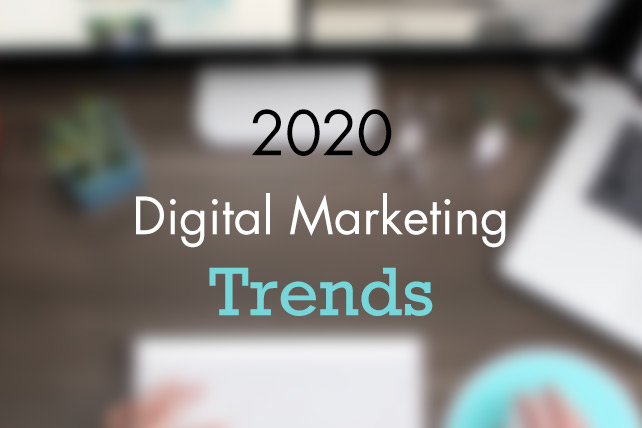
We are excited for the changes new digital marketing channels, strategies, and techniques bring each year, and we are sure 2020 will not disappoint. In the past, digital marketing trends have been largely focused on new technologies driving the change, and this coming year will most likely be the same. With changes in social media, PPC, SEO, and content marketing, it’s hard to keep up with what is new. Below, we break down some of the digital marketing trends we recommend keeping an eye on in 2020.
1. Instagram Stories and Instagram Story Ads
As social media users, we find it hard to remember the days when Instagram didn’t have Stories. As marketers, we find that the disappearing content is still the new (social) frontier.
Instagram Stories are full-screen, immersive content, in the form of photos and videos that live on the platform for 24 hours before disappearing. They can include interactive components such as polls and ratings to engage viewers. They can also broaden the creativity of a single photo by incorporating fun and timely additions, such as music or GIFs.
For brands that use social for more than advertising, but also as an interactive communication platform with their audience, Instagram Stories are almost becoming a necessity. Stories sharing is set to surpass Instagram feed sharing in 2020 and engagement rates on Instagram Stories are significantly higher than in the IG feed itself and on Facebook’s story equivalent.
If engagement is your focus, Stories are extremely effective for brands targeting younger audiences, e-commerce brands, and those in the fashion, home decor, or food spaces.
Unlike posts to your feed, Story posts and ads require creative that is designed specifically for the Instagram platform. If you want to see meaningful engagement with your Instagram Stories ads and posts, republishing content built for another network or channel might not work. Instead, the content for your Story needs to look and feel native to the platform and be at least reasonably “real time.” In 2020, the savvier brands will move more of their influencer content to their Stories where influencers feel more “real and raw” in the Stories space, making it a more approachable way to share sponsored content that feels less like an ad.
2. Facebook and Instagram “like counts” are Going Away
Facebook and Instagram are set to remove like counts from posts, no longer making them public, while users will still be able to see their own like counts behind the scenes. This shift is being driven by the objective to decrease competitive pressure among people on the photo-sharing services, and in turn, to promote more freedom of creativity. This change will likely result in a drop of average like counts, at least initially, and force brands and influencers to engage with consumers in more meaningful ways (i.e., comments, shares, messages). Savvy brands will start to adapt their social strategies to focus on content that spurs conversation vs. pushes a singular message.
Overall, we believe content is going to shift from high-production value, polished pieces to more ephemeral and real-time content. Successful brands will create content that feels more organic (and less like an ad) and use social media (direct messaging in particular) to engage with consumers vs. talk at them with ads. We predict a shift back to more frequent sharing (with lower-production value content) vs. the model of less content, but higher-production value that we are seeing now.
3. Microsoft Ad Network and LinkedIn Data Integration
We all know Google is the behemoth when it comes to search engines with 88%+ of the global search market, but Bing—a Microsoft-owned search engine—is making moves with the hopes of growing their share, especially in the paid space.
Following Microsoft’s acquisition of LinkedIn, they announced the ability to leverage job function, company, and industry data in targeting for paid search ads on Bing. Although this news isn’t necessarily “new” (since it was announced in 2018, after all), LinkedIn is having a bit of moment right now. The channel continues to see astonishing growth with two new professionals joining LinkedIn every second, and 50% of Americans with a college degree having a LinkedIn profile. In the B2B space, this data is critical in helping marketers reach their ideal audience. With the addition of LinkedIn, Bing is able to do the unheard of by layering targeting capabilities on top of paid search campaigns thereby increasing their effectiveness.
For example, if you were marketing your new marketing automation platform for enterprise businesses, your search campaigns can still target the terms around “best marketing automation platform.” With these recent changes however, you can also restrict it to display only to your target accounts (using Company data from LinkedIn) or decision-makers (using Job Functions), increasing your relevancy and ability to tailor your messaging. We think this change will bring big opportunities to the already competitive B2B marketing space, and we are excited for it.
4. Lead Ads Coming to Search and Video
Lead ads were first introduced by Facebook back in 2015 and since then, have become a lead gen staple in digital marketing. The lead ad format provides overall ease to both the marketer and the visitor by collecting the visitor’s conversion information directly on the channel the ad is served. For marketers, this means decreased drop-off and increased conversion. For visitors, this means no longer having to choose between staying on the channel you are surfing versus registering for or downloading the content you want.
Lead ads have been around for some time, so why are we talking about them now? Google has recently launched lead ads in YouTube campaigns and now as an extension in search ads. This means visitors can convert directly in the SERP or while watching your video content. In Google search results, this new ad extension comes with some additional benefits such as prepopulated fields for logged in Google users and increased ad size in the SERP for lead ad placements.
5. Interactive Content
The goal: cutting through the clutter with new ways to consume information, mobile-friendly experiences and staying ahead of the curve. Let’s face it – consumers are getting more savvy. Remember when paid display ads were still a novelty? Some believe gated content and forms are nearing the same tipping point, especially in certain industries. Visitors know your gated content will result in a drip campaign or sales call sooner than they would like. How do you stay ahead of it while growing engagement and conversion? Focus on providing value first, lead gen second.
Gated content is not dead, but the engagements that occur before a conversion are becoming more critical. Leveraging polls, quizzes, video, conversational chatbots, and interactive live content like Facebook Live/IGTV are all great ways to get your audience to engage with your brand while providing them value and building trust – before ever asking for an email. One of the fastest growing conversational marketing companies, Drift, actually did away with all forms on their website and the stats were incredible. As we near 2020, we believe these tactics will continue to grow in popularity as companies continue to strive to drive meaningful engagements with their brand that ultimately drive customers.
6. Google’s BERT Update
You know that friend that reads your mind and finishes your sentences for you? In the search engine world, that friend is BERT. It’s Google’s most recent algorithm change focused on improving search results by better understanding natural language through the context of the sum of all words in a search query. It’s undoubtedly the largest change in Google’s search algorithm to date and is expected to impact one in every ten search queries.
So, what is BERT exactly? BERT stands for Bidirectional Encoder Representations from Transformers. Google has introduced new transformer models to analyze search queries by looking at and understanding the semantics of what a single word means when it is used in a statement with another. Previously, the Hummingbird update enabled Google to look at all words together in a string of keywords to better serve up results, rather than looking at each keyword singularly. With this recent BERT change, however, Google is not only looking at strings of keywords together but working towards understanding the true meaning behind each word within them. For example, prepositions were not considered previously when determining the most relevant search results but, as we know, words like “from” and “to” can shape the meaning of our search immensely.
BERT is arguably one of the most important updates to date for marketers to understand. Typically, marketers ask, “How can I optimize for [insert recent algorithm change]” and with BERT, the answer is you can’t. You need to optimize for your audience. The way people search is changing, so your content needs to change with them. Today, people are typing (or using voice) in search engines the same way they would ask a friend a question—using long-tail queries where the sum of all words provide more context than the individual terms themselves. This means now more than ever that your content needs to be geared towards how your audience speaks and thinks. Writing in a conversational, intent-based focus can help you produce the content that satisfies your audiences’ queries and reaches them through organic. Learn more about content clusters from our 2019 Digital Trends article for more on how to get started.
The Takeaway
As you can see, there is a lot to be excited about for digital marketing in 2020 and beyond. Everything could not make our shortlist, but a few other digital marketing trends that we are watching and leveraging in our 2020 marketing plans include:
- Chatbots and conversational marketing
- SERP Zero results
- Custom intent targeting
- Privacy and data management, including CCPA
The digital marketer should strap in for 2020 as we expect it will be an exciting time with new technologies, advancements, and trends that are sure to shape the coming years. Stay tuned.
About VONT Performance Digital Marketing
At VONT we believe that change is the only constant in the digital world – and that excites us. When tools and environments are constantly changing, new opportunities to help our clients achieve success are constantly arising. Each new advertising technology, social platform, or design approach allows us to improve on the results we achieve for our clients.
We believe in this idea of continual fine-tuning so much that we named our company VONT, which means to achieve exponential improvement in incremental steps. It is our core belief, and the reason why we are not simply a web design company or simply a digital advertising agency, but rather a long-term, single source partner providing a comprehensive array of web development and digital marketing capabilities.
In short, we’re here so that our clients achieve success in the ever-changing digital world. If you’d like to learn more about VONT and the work we’ve done with our client partners, visit our Work page. Or, if you have a question, contact us. We’ll get right back to you!

